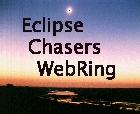I keep reminding myself about much of these importances before every eclipse .
I thought I might point out some for the benefit of you-all.
(1) Everyone, novice (I prefer use virgin) or not needs to take time to just stare and look at the vista. Even I did that during the 2001 eclipse (finally!).
(2) If you need to protograph the Sun with a camera, it is most important that you make sure that the FLASH is set to OFF.
A flash next to someone blinds them a few precious seconds. In my 1998 video, you can see hundreds of flashes all over the ship Galaxy. A flash will do no good.
Plus it should be on manual not auto (that goes for camcorders too).
Kodak actually has information about how to set your camera for the eclipse depending on what you want to see. I will post all of this on my blog in the near future and well let you know. Your camera does not act like your "EYE". Your eye can see everything at once but the camera will not.
(3) Be prepared because when that shadow starts coming in, things really start to get amazing. It is unlike anything you can see. Like many others you might forget everything you have learned, know or have carefully preplanned (happens all the time). One person aboard the Canberra at 1973, I heard did not take off their eclipse sunglasses and did not understand why things were so dark!!!
(4) Check your equipment before the eclipse and make sure you have batteries etc and everything. My other camcorder failed before totality but luckily I had a backup and had my camera ready to shoot the eclipse sun (featured in Astronomy magazine Dec 2001).
(5) I won't take the time to look at totality with a telescope. Binoculars are probably better. I will use my camer, camcorder and my eyes. I suggest if there are people with a telescope in the group who will offer a peak, please gather near them. Make sure you have permission before totality. They might not have time.
My research mainly has dealt with the environment during total eclipses and how the environment changes before and during totality. You will see a big difference when the sun is covered at 50% but when it starts getting closer well things really change.
(6) Be prepared not to walk too far during totality. In 1972 it was very dark (smaller shaodw cone and less light filtering in). . I could not even see my camera dial settings. In 1979 with the snow it was brighter. 1973 and 2001 were different. Much lighter but still like the dark of the full moon. Be prepared to stay close.
(7) In 1999, there were shadow bands before totality but not after. I could not see them but others could. I was too busy. Your eyes might not be able to focus on them before totality as the light continues to dim. In 2001, I did not seem them before hand but we saw them after totality for over 6 minutes and I was able to videotape them. If you want to look for shadow bands, a white cloth or sheet is needed. Seeing them was one of my all time eclipse highlights and that in 2001. But we might not see them.
(8) That also reminds me. I now where hearning aids mostly during working with students, working with groups etc. If you were them, make sure you have enough. I did not put them in before my encounter with a tornado in May as we were so rushed. The other two guys I was chasing with hear some extra noises relating to the incoming tornado (I hear them now on the video I took of the tornado). If you want to hear everything going on as well seeing during those precious moments, make sure to have your hearing aids in and contacts in!! ( I am glad I wrote this as I might not have thought about it before our trip).
Dr. Eric Flescher
Wednesday, June 3, 2009
total eclipse: Make sure to turn off your camera flash so as to not stun others Mr. Spock
Labels:
astronomy,
eclipse 2009,
eclipse eclipses
Subscribe to:
Post Comments (Atom)








No comments:
Post a Comment